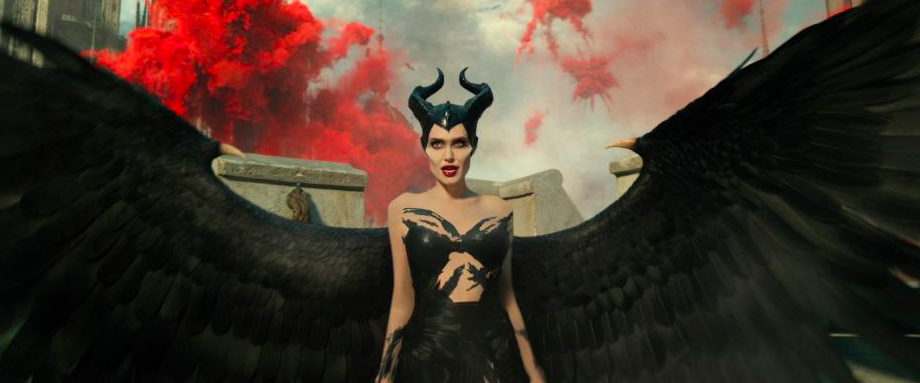
Diedre Johnson is a Los Angeles-based former staff writer covering…
Upon watching Maleficent: Mistress of Evil, it’s clear — the 21st century hasn’t called Houston yet but it does have a few societal problems.
With its grandiose set design, bold swaths of color, magical special effects, and award-winning, international cast, the sequel Maleficent: Mistress of Evil tries to rectify the situation.
The sequel is a wise tale that slyly or not so slyly points at our need for unity, acceptance, and taking care of our environment.
For those who haven’t seen the first film, it’s a story about a fairy forest (what else? Maleficent is a fairytale loosely based on Sleeping Beauty) and a young fairy woman (played by Angelina Jolie) who lives there. She is somewhat innocent until the politics of the nearby kingdom interfere, and Maleficent is sabotaged by the one she loves.

Seeking revenge, Maleficent puts an evil spell on Aurora, the baby daughter (Elle Fanning) of the new king. As the years go by, Maleficent’s heart softens towards the child and instead of hating her, she comes to love her and treat her as her own.
They live in the verdant land of the Moors, which has great beauty, but just like areas of the Earth today, there’s always someone trying to leverage it to death for their own needs.
In this case it’s Queen Ingrith of Ulstead, played with relish by Michelle Pfeiffer. Pfeiffer dips into the role of the greedy ruler as if she’s played only villains all her screen life. Queen Ingrith’s son is Aurora’s true love, Prince Phillip (Harris Dickinson). Ingrith is seemingly much more interested in overthrowing Maleficent and acquiring the Moors than she is with her son’s happiness or her husband, King John (Robert Lindsay).

Two negative themes are on display in this sequel. One is the need to strip a community, land, or country of its resources for the larger and “greater” good. Ingrith has some long-held grudge of the Moors, based on a childhood incident. She wants to take over the fertile land for her kingdom’s purposes. The fairies, as inhabitants of the kingdom as well as protectors, treat it with respect. As they flutter and fly around, it’s clear that they love their natural environment as is.
The second is the ongoing, polarizing belief that those who are different physically and/or culturally should not be allowed to peacefully coexist.
The fairy folk are striving to be accepted for who they are and have seen, through the relationship between Aurora and Maleficent, that love is love, regardless of your origins.
They are fiercely loyal to Aurora, now Queen of the Moors, and to Maleficent. They also are in favor of Aurora marrying Phillip, thus joining the two kingdoms together in harmony through a common thread.
Meanwhile, an accident leads Maleficent to discover her own origins and what happens when groups are forced to live and survive in a land that was not originally their own. Finding her “people” gives Maleficent courage to face her own demons and the pride to rise up again.
Chiwetel Ejiofor stars with Jolie for the second time (the first was in the spy thriller, Salt, in 2010). Here he plays a brave and benevolent fairy, Conall, who rescues Maleficent from almost certain death after a run-in with Ingrith.
With patience, Conall coaxes Maleficent into the fairy fold and serves as a catalyst for her discovering her roots and forming a bond.
In the five years between films, it looks as if the screenwriters Linda Woolverton, Noah Harpster, and Micah Fitzerman-Blue have taken a page out of the diversity catalogue. The winged fairies that make up Maleficent’s peeps are definitely multiracial, as in all races and hues. This is also true of the people in the principality of Ulstead.

With direction by Joachim Ronning, there’s a slight nod to Wakanda as the fairies appear to take deep pride in their own tribal traditions, such as well as keeping their magic powers alive (despite displacement), teaching their children to use their wings, and dancing at night near an open fire. They are also warriors.
It seems also as if the writers wrote the sequel with Jolie’s obvious love of children in mind. In scene after scene her character is near or interacting with children of all races. At one point, as she interacts with a little African-American girl, then a Caucasian child, one can’t help but think of her real-life multiracial family.
With the world at odds and with the rising amounts of blatant prejudice and racism, the message is clear; we are all in this together and the differences we have are too few to argue.
Maleficent: Mistress of Evil opens in theatres on October 18th.
On a scale of one to five, this gets a five.
Diedre Johnson is a Los Angeles-based former staff writer covering entertainment whose work has appeared in Variety, The New York Daily News, TV Guide.com, The Crisis, Vogue Japan and Italia, and Harper’s Bazaar China, among others









